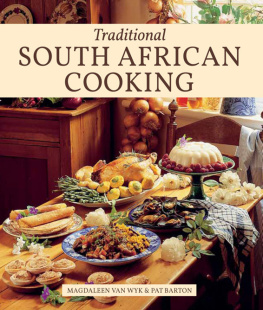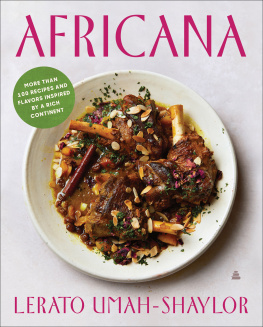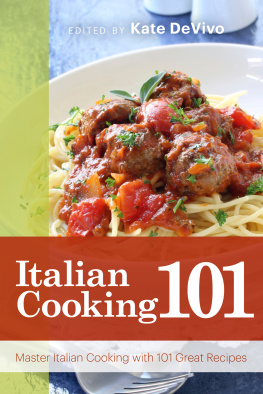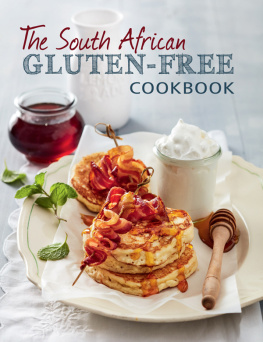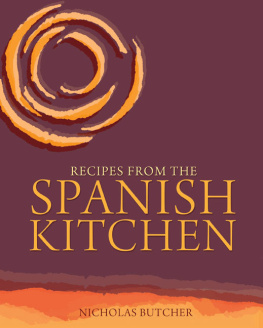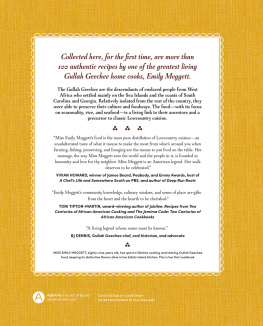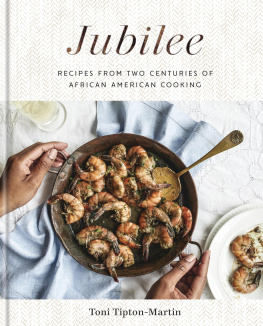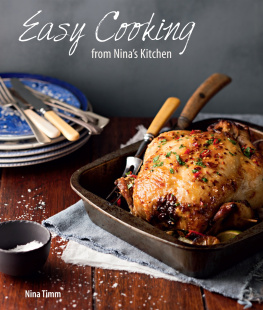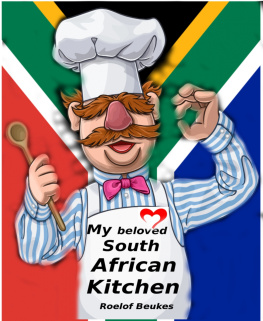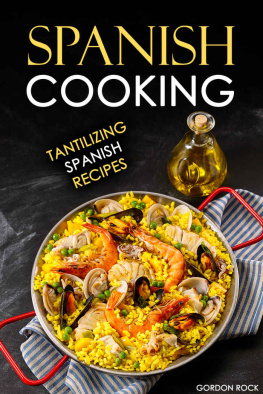ACKNOWLEDGEMENTS
The authors would like to thank Flesch Financial Publications for permission to use material from Leipoldts Cape Cookery, Faldela Williams for material from The Cape Malay Cookbook, and Renata Coetzee for material from The South African Culinary Tradition and Funa.
The photographer, stylist and publishers would like to thank the following persons and companies in Cape Town for the crockery and material which they so kindly supplied:
Bric-a-Brac Lane, Claremont
Clarewood Antiques and Interiors, Claremont
Clementina van der Walt, Paarl
Fabric Library
Med Blue, Glencairn
Peter Visser Interiors
The Potters Shop, Kalk Bay
Val Prout, Franschhoek
Wendy Hofmeyer, Rondebosch
Sylvia Grobbelaar, Oranjezicht
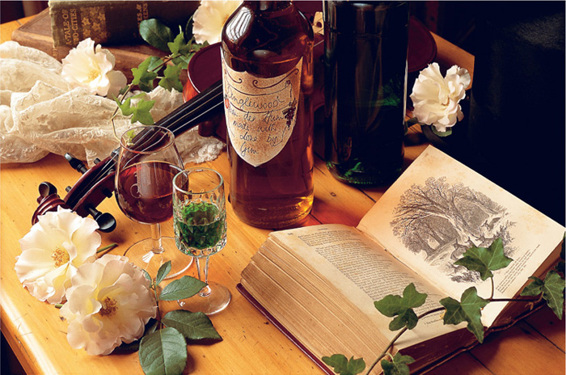
SOUPS, STARTERS AND SNACKS
Modern hors doeuvres or starters did not really feature in the early days of settlement in South Africa. They were introduced, much later, by immigrants from continental Europe. Virtually the only starters or snacks made in those early days were Eastern fish sambals or cooked bone marrow, both served with brown bread and butter. Following the Western European model, soup was then the chosen way to start a meal, and even the humblest kitchen relied on a good soup to stimulate appetites. Spices and flavourings were added during cooking, and the completed dish served at table; cooks considered it an affront to their skill if diners added seasoning to the soup themselves.

STOCK
The constantly simmering stockpot was a prominent feature of every kitchen in days gone by. Into it went every scrap of leftover meat, as well as bones and vegetable trimmings in fact, virtually everything that could help to improve the flavour of the stock. I remember the old coal range in my grandmothers kitchen, with its big black stockpot (and, of course, the eternal coffee pot!) and I can still taste the delicious ertjiesop (see Green Pea Soup, ).
The slow cooker is the perfect modern equivalent of the stockpot and can be used for cooking both stocks and soups. For speed and convenience but only if you are making reasonably small quantities the microwave oven is ideal.
Stocks are not only a base for soups, although this is their primary use, but they are also used to add flavour to sauces, stews and casseroles. Stock is perhaps better cooked conventionally on a stove because it needs long, slow cooking for the most flavourful results. If you wish to make stock in your microwave oven, however, do not make more than 2 litres of liquid at a time (depending on the size of your oven). See the individual recipes for microwave times and settings.
HERE ARE SOME TIPS FOR MAKING STOCK
- Use a large heavy-based saucepan with a close-fitting lid.
- Soak the bones in cold water for 30 minutes to 1 hour, then heat slowly to boiling point. Use 500 ml to 1 litre water for every 500 g meat and bones.
- For extra flavour and colour, first roast the meat and bones in the oven until browned, or fry them until brown before adding the water.
- Gently simmer the bones and the meat for about 23 hours, adding the vegetables, spices, salt and herbs only during the last hour.
- Do not use too many green vegetables when you make stock, as they will impart a bitter flavour.
- Starchy ingredients, like potato or thickened gravy, will cloud the stock and give it a bitter taste, so add very small quantities or none at all.
- Do not use the water in which bacon or salt beef has been cooked to make stock, as it is far too salty.
- As soon as the stock is cooked, strain it into a clean, non- metallic bowl and leave to cool. If the stock is to be used immediately, remove the fat by skimming or mopping the surface of the stock with absorbent kitchen paper. Alternatively, leave the stock in the refrigerator, unskimmed, for up to two weeks. The fat will harden and will then be easier to remove when the stock is to be used. This layer of fat helps to preserve the stock, as it excludes air.
- Never leave stock standing in a saucepan it will become sour.
REHEATING SOUPS IN THE MICROWAVE OVEN
- Place the soup in a deep, non-metallic container large enough to prevent boiling over.
- Heat, uncovered, until the soup bubbles, stirring several times during heating.
- Heat at 100 per cent power for the following periods: 3 minutes for 250 ml; 612 minutes for 500 ml; 812 minutes for 750 ml; and 13 minutes for 1 litre.
- Take particular care when reheating cream- and milk-based soups. They will curdle if they are allowed to boil.
FISH STOCK
- 1 kg fish heads, bones and trimmings
- 1 medium onion, sliced
- 1 medium carrot, sliced
- 1 stalk celery, chopped
- 1 bouquet garni (3 sprigs of parsley, 1 sprig of thyme, 1 bay leaf)
- 1.5 litres water
- 125 ml dry white wine (optional)
- 5 ml salt
- Rinse the fish bits and pieces very well, then place them in a saucepan with the vegetables, bouquet garni, water and wine. Add the salt and bring slowly to the boil. Remove the scum as it rises to the surface. When there is no scum left, half cover the saucepan and simmer the stock for about 30 minutes. Strain through a fine sieve and cool, then refrigerate or freeze until needed
- MICROWAVE OVEN Place the ingredients in a deep microwave bowl and microwave at 100 per cent power for 8 minutes, or until boiling. Reduce the power to 50 per cent and microwave for 10 minutes.
Makes 1.25 litres
MEAT (BEEF) STOCK
- 1 kg beef shin or neck
- 30 ml butter or fat
- 10 ml salt
- 5 black peppercorns
- 3 whole cloves
- 1.5 litres cold water
- 3 medium carrots, chopped
- 3 medium turnips, chopped
- 3 medium leeks, chopped
- 3 stalks celery, chopped
- 3 medium onions, coarsely chopped
- 1 bouquet garni (3 sprigs of parsley, 1 sprig of thyme, 1 bay leaf)
- Cut the meat from the bone and dice it. Chop the bones into smaller pieces. Melt the butter or fat in a large saucepan and brown the meat and bones. Add the salt, spices and water. Bring to the boil, then cover and simmer for 34 hours, skimming the surface when necessary. Add the vegetables and bouquet garni, and simmer for a further hour. Top up with water, then strain through a fine sieve and set aside to cool. Remove the layer of fat that forms on top of the stock and strain it again, if necessary.
- MICROWAVE OVEN Brown the meat as described in the recipe. Transfer to a large, deep microwave bowl and add the salt, peppercorns, cloves and water. Microwave at 100 per cent power for 810 minutes. Add the vegetables and bouquet garni, reduce the power to 50 per cent and microwave for approximately 55 minutes.
Makes 1 litre
GAME STOCK
- 85 g bacon, diced
- 1 kg venison, cubed and bones chopped
- 500 g beef shin or neck, boned and meat diced
- 3.75 litres water
- 15 ml salt
- 2 medium carrots, diced
- 1 large turnip, diced
- 1 large onion, diced
- 2 stalks celery, diced
- 3 white button mushrooms, sliced
- 6 peppercorns
- 4 whole cloves
- 1 bouquet garni (3 sprigs of parsley, 1 sprig of thyme, 1 bay leaf)

